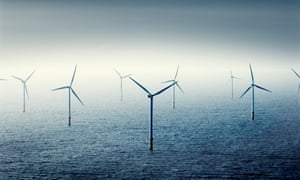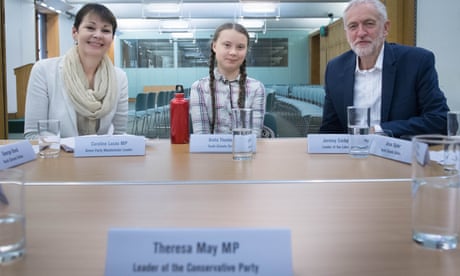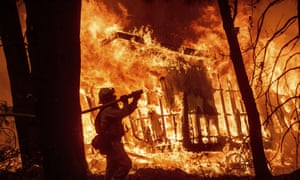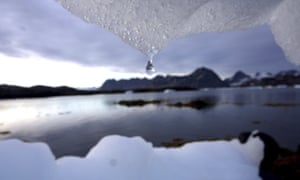It's time for nations to unite around an International Green New Deal
'The stakes of the international Green New Deal
are not merely environmental.’
Photograph: Craig Easton/Getty Images/Cultura RF
Several countries have proposed their own versions of a Green New Deal, but climate change knows no borders. We need a global response
Yanis Varoufakis and David Adler
Tue 23 Apr 2019
In times of crisis and catastrophe, children are often forced to grow up quickly. We are now witnessing this premature call to action on a planetary scale. As the adults in government accelerate their consumption of fossil fuels, children are leading the campaign against our species’ looming extinction. Our survival now depends on the prospects for a global movement to follow their lead and demand an International Green New Deal.
Several countries have proposed their own versions of a Green New Deal. Here in Europe, DiEM25 and our European Spring coalition are campaigning under the banner of a detailed Green New Deal agenda. In the UK, a new campaign is pushing similar legislation with MPs such as Caroline Lucas and Clive Lewis. And in the US, dogged activists in the Sunrise Movement are working with representatives such as Alexandria Ocasio-Cortez to push their proposal to the front of the political agenda.
Glaciers and Arctic ice are vanishing. Time to get radical before it's too late
Bill McKibben
But these campaigns have largely remained siloed. Their advisers may exchange notes and ideas, but no strategy has emerged to coordinate these campaigns in a broader, global framework.
Unfortunately, climate change knows no borders. The US may be the second-largest polluter in the world, but it makes up less than 15% of global greenhouse emissions. Leading by example is simply not enough.
Instead, we need an International Green New Deal: a pragmatic plan to raise $8tn – 5% of global GDP – each year, coordinate its investment in the transition to renewable energy and commit to providing climate protections on the basis of countries’ needs, rather than their means.
Call it the Organization for Emergency Environmental Cooperation – the namesake of the original OEEC 75 years ago. While many US activists find inspiration in a “second world war-style mobilization”, the International Green New Deal is better modeled by the Marshall plan that followed it. With financial assistance from the US government, 16 countries formed the Organization for European Economic Cooperation (OEEC), dedicated to rebuilding the infrastructure of a devastated continent and coordinating its supply of energy.
But if the original OEEC entrenched an extractive capitalism at Europe’s core –protecting the steel and coal cartel – the new organization for an International Green New Deal can empower communities around the world in a single transformational project.
The transnational scope of this mobilization is crucial for three main reasons.
The first is production. Recent studies show that, as long as countries cooperate, all continents have the wind, solar and hydropower resources they need in a zero-emissions world. Northern countries and mountainous regions have better access to wind power, while southern lands are better suited to exploiting the sun. An International Green New Deal could exploit these differences and ensure that renewable energy is available to all of them year-round.
Confronting the climate crisis will require more than keeping fossil fuels in the ground
The second is innovation. Confronting the climate crisis will require more than keeping fossil fuels in the ground. We will also need major scientific breakthroughs to develop renewable sources of energy, adapt existing infrastructure, detoxify our oceans and decarbonize the atmosphere. No country alone can fund the research and development necessary to meet these challenges. The OEEC would pool the brainpower of the global scientific community: a Green Manhattan Project.
The third is reparation. For centuries, countries such as the US and the UK have plundered natural resources from around the world and polluted them back out. Less developed nations have been doubly dispossessed: first, of their resource wealth, and second, of their right to a sustainable life – and in the case of many small island developing states, of their very right to exist. An International Green New Deal would redistribute resources to rehabilitate overexploited regions, protect against rising sea levels, and guarantee a decent standard of living to all climate refugees.
The UN climate change conferences will not save us from extinction – the demise of the Paris agreement should be evidence enough. These frameworks lock us into prisoners’ dilemmas, in which every country has an incentive to defect on their climate commitments, even if cooperation between them would yield a greater collective good. As long as climate cooperation is framed around sacrifice, it is vulnerable to strongmen like Donald Trump who vow to buck international rules in the name of national interests.
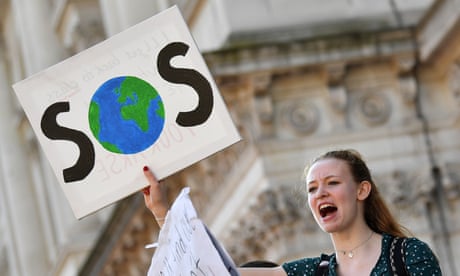
The International Green New Deal changes the frame. Rather than pleading for restraint, it sets out a positive-sum vision of international investment, in which the gains from joining in outweigh those to going it alone.
This is the strategy that won Franklin D Roosevelt the original New Deal. His plan addressed people who had given up hope and inspired in them the idea that there is an alternative. That there are ways of pressing idle resources into public service. It made sense to the disheartened and offered opportunity to the entrepreneurial.
The same is true of the International Green New Deal, which mobilizes public finance to crowd in private investments that, together, fund the $8tn transition. Just like in the original New Deal, public financing will involve a mix of taxes and bond instruments. On the former, we can introduce a global minimum corporate tax rate that is then redistributed on the basis of their sales. On the latter, public investment banks – including the European Investment Bank, the World Bank and the KfW, Germany’s state-owned development bank – can coordinate the issue of green bonds that the major central banks agree collectively to support in the secondary markets.
Suddenly, countries with large trade surpluses will realize they are better able to invest their excess capital if green investments in deficit countries are coordinated under the auspices of an international plan. The positive-sum dynamic will prevail.
In this sense, the stakes of the International Green New Deal are not merely environmental. By uniting countries in the project of bottom-up economic transformation – and coercing multinationals to fund their fair share of it – it will also stem the tide of bigotry and xenophobia engulfing the world.
“Advanced” capitalist countries today are literally falling apart. In the US, net public investment has fallen below half of one per cent of GDP. Across the eurozone, net public investment has remained below zero for nearly a decade. It is little wonder that political monsters are rising again: just as in the 1930s, the grapes of wrath are ripening and “growing heavy for the vintage”.
To revive the liberal democratic project, some pundits have suggested making China into a bogeyman. But the real bogeyman is of our creation: a climate crisis wrought by decades of inaction and underinvestment. To address the true existential threat that we face today, we must reverse the economic policies that brought us to this brink. Austerity means extinction.
The promise of an International Green New Deal to is to avoid the pitfalls of cold war politics and unite humanity in the only project capable of preserving a habitable planet. To do this, however, we need a powerful progressive international movement to demand that our leaders begin to act beyond their own borders. Let’s start building it. The children are watching.
Yanis Varoufakis is the co-founder of the Democracy in Europe Movement and the former finance minister of Greece. David Adler is a writer and a member of DiEM25’s Coordinating Collective. He lives in Athens, Greece
Global warming has increased global economic inequality
Noah S. Diffenbaugh and Marshall Burke
https://plawiuk.blogspot.com/2019/04/global-warming-has-increased-global.html
PNAS first published April 22, 2019
PNAS first published April 22, 2019
